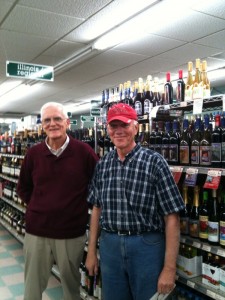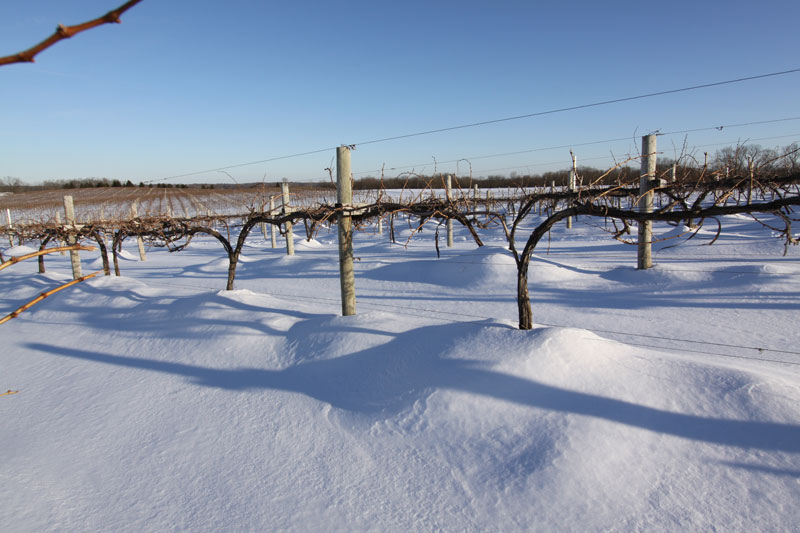Chardonel or Chardonnay? Herman’s Liquors Helps Midwest Wine Clients Decide

Joe (left) and Jim Ferrero have operated Herman’s Liquor Store in Ottawa, Illinois since 1977
Often, it’s hard to find a parking spot at Herman’s Liquor Store in Ottawa, Illinois. The lines at the check out counter, always managed by at least two friendly and knowledgeable staff, attest to the popularity of the place. Once inside, you realize that this is not an ordinary liquor store. The well-stocked shelves not only display carefully selected wine from around the world, but also a wide range of wines from the Midwest.
Behind the counter and ready to greet customers by name are the owners, Jim and Joe Ferrero, who took over the business from their father Herman in 1977. Jim and Joe are convinced that their variety of wines and their prices surpass that of any other store in central Illinois.
Within the last five years, Midwest wines have become an important part of their sales. They first began carrying Michigan’s Tabor Hill, and today they display the products of sixteen Midwestern wineries and twenty labels. Their biggest Midwest wine seller is from nearby August Hill Winery, located in Utica, Illinois, next to Starved Rock State Park.
On matters of wine, Joe usually defers to Jim, who is always ready to offer customers first-hand information on the products he sells. When he travels, he visits wineries, both here and abroad. When asked how Herman’s determines which regional wines it will carry, Jim says, ‘The wineries contact us. But if they don’t have a distribution network, we don’t have a way to bring the wines in. For example, Alto Pass Winery (in southern Illinois) came to the wine show in Ottawa last June and contacted us. They’ve now established a distribution network, and in November we started carrying four different types of their wines.”
Both Jim and Joe know that for the smaller wineries, distribution is a major concern, as it is for the retailers who handle their product. A salesman might bring in three or four cases to start, but the store finds it difficult to replenish the supply. ‘There are more southern Illinois wines that we’d like to carry,” Jim says. ‘But we can’t drive to southern Illinois to pick them up.”
Fortunately, Herman’s has special relationships with several regional wine makers. St. James of Missouri has visited the store to do a wine tasting. But the strongest relationships, Jim and Joe concur, are with nearby August Hill and with Blue Sky Vineyard near Carbondale, Illinois, in deep southern Illinois. Blue Sky labels have been successful because the owner of Blue Sky grew up in Ottawa and is able to make deliveries when he comes to town to visit or for wine festivals.
One major boost for Illinois wines in the area has been ‘Vintage Illinois,” an Illinois wine festival held at Matthiessen Park about twelve miles from Ottawa. The 2011 event drew approximately 7,000 people from around the state. The first Ottawa 2 Rivers Wine Fest , held this past summer, also shows promise as a successful annual event. That festival, Jim says, led to Herman’s picking up Galena Cellars Vineyard and Winery in northwestern Illinois. ‘Any exposure to different varieties always helps,” Jim says. Herman’s now carries wines from Michigan, Missouri, Indiana, and Illinois.
Jim and Joe point to two factors that affect the potential of smaller wineries to compete at liquor stores. One, of course, is distribution. Another is pricing. Illinois wineries with small production have one-case pricing, according to the brothers, while large California wineries and big distributors that handle them, have volume discounts. Nevertheless, regional wines, they say, are a growing segment of their sales, while many other labels are flat.
Both brothers came into their father’s liquor business after graduating from the University of Illinois (Jim with a bachelor’s in finance and Joe with a master’s in earth science) and pursuing careers in their respective fields as young men. They now have spent forty years together in the business, and they know how to make it work. When asked what advice they would give to regional wineries that want their products on the shelves of Midwestern liquor stores, they are unequivocal.
Their experience shows them that when a shelf is growing empty and they need a delivery, the salesmen cannot leave spots empty on the shelf. ‘If they do,” Jim says, ‘they harm their product. That’s their spot, and they should make the most of it to merchandise their wines, first by filling the spot, then by making certain there are explanations for the wines they put there.”
The latter is particularly important for customers who do not know regional wines, Jim and Joe believe. ‘For example,” Jim explains, ‘a wine guy who knows Chardonnay may want to know, ‘Well, what’s Chardonel?’ You know, the descriptions are important for Midwestern wines, more so than for California wines, which have been around for a long time. And for the most part, our regional wine salesmen don’t do the stocking or the descriptions. You know, Zinfandel from California…one description doesn’t vary from another. But if you have strawberry/rhubarb, you should let people know something about it.”
Lately, Jim and Joe’s point seems to be getting through. Herman’s shelves of regional wines are by and large replete, and their wine customers are getting to know their Chardonel.



